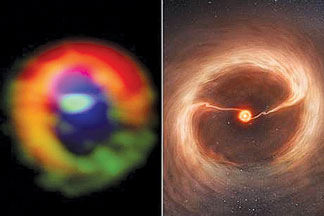First image of a new planet formed with star dust
The world's highest radio telescope, built on a Chilean plateau in
the Andes 5,000 metres above sea level, has captured the first image of
a new planet being formed as it gobbles up the cosmic dust and gas
surrounding a distant star.
|

The world's highest radio telescope captures image (left)
providing evidence of how ‘gas’ planets are formed |
Astronomers have long predicted that giant "gas" planets similar to
Jupiter would form by collecting the dust and debris that forms around a
young star. Now they have the first visual evidence to support the
phenomenon, scientists said.
The image taken by the Atacama Millimetre-submillimetre Array (ALMA)
in Chile shows two streams of gas connecting the inner and outer disks
of cosmic material surrounding the star HD 142527, which is about 450
light-years from Earth.
Astronomers believe the gas streamers are the result of two giant
planets - too small to be visible in this image - exerting a
gravitational pull on the cloud of surrounding dust and gas, causing the
material to flow from the outer to inner stellar disks, said Simon
Casassus of the University of Chile in Santiago.
"The most natural interpretation for the flows seen by ALMA is that
the putative proto-planets are pulling streams of gas inward towards
them that are channelled by their gravity. Much of the gas then
overshoots the planets and continues inward to the portion of the disk
close to the star, where it can eventually fall onto the star itself,"
Dr Casassus said.
"Astronomers have been predicting that these streams exist, but this
is the first time we've been able to see them directly. Thanks to the
new ALMA telescope, we've been able to get direct observations to
illuminate current theories of how planets are formed," he said.
The image, published in the journal Nature, appears to answer a
long-standing conundrum of star formation: how does a new sun continue
to grow by accumulating cosmic material when orbiting proto-planets are
busy gobbling up the same source of cosmic dust and gas, creating huge
gaps in the star-forming cloud of material.
"This has been a bit of a mystery, but now we have found a process
that allows the star to continue to grow despite the gap," Dr Casassus
said.
- The Independent
|



